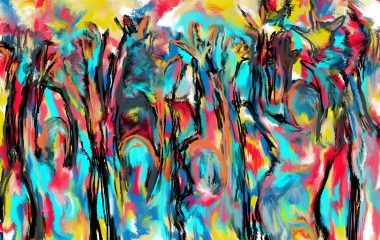
One of the most central requirements of Jewish life—both in time and importance—is that of daily prayer. Yet most fascinatingly, the source of the obligation to pray—or whether such an obligation even exists—is a matter of great debate. It is the Rambam, and few (if any) others, who claim that there is a biblical obligation of daily prayer—and even such obligation is fulfilled by prayer once daily. The Ramban, who disputes the premise that we are obligated to pray, argues that prayer is “from the attributes of kindness the Creator, blessed be He, gave to us; that He hears and answers our prayers[1] whenever we call upon Him” (Sefer Hamitzvot, positive mitzvah #5).
Not only is the source of prayer in dispute, so is its origin. “It was taught: Shimon Hepekuli formulated the 18 blessings (shmoneh esrei) before Rabban Gamliel in a proper order at Yavneh” (Megillah 17b). This teaching dates the shmoneh esrei, the primary element of prayer, to the second century CE in the generations following the destruction of the Temple. However, the Talmud quotes the view of Rav Yochanan that “120 elders, and amongst them a number of prophets, established 18 blessings in order”. The 120 elders is a reference to the anshei knesset hagedolah, who led the Jewish people at the beginning of the second Temple period—the same time that prophecy came to an end. This teaching dates the shmoneh esrei some 600 years earlier than Shimon Hapekuli.
To resolve this contradiction, the Gemara says that “it was forgotten and he reformulated them” (ibid 18a). This is a rather amazing statement. Apparently, so few people actually recited the prayers instituted by the anshei knesset hagedolah that they were nearly forgotten. These same prayers had to be reintroduced hundreds of years later. It is noteworthy that while the Ramban argues that normally, there is no obligation to pray, he does admit that in a time of great need not just prayer, but communal prayer becomes mandated[2]. Prayer—calling out to G-d—is our first, but not our only response to crisis.
The first iteration of the shemoneh esrei was established by the greatest leaders of the Jewish people, including a number of prophets. This was a point often referenced by Rabbi Soloveitchik, who opposed all prayer innovations (including special kinnot for the Holocaust and the prayer for the State of Israel), arguing that, absent prophets, we are just not qualified to introduce new prayers. Yet this view is not generally accepted—perhaps because the second iteration of the shemoneh esrei was introduced by Shimon Hapekuli. If that name is unfamiliar, that is for good reason. To the best of my knowledge (and the reference books I used), this is the only reference to him in all of Talmudic literature. As Rashi notes, pekuli means cotton, and suggests that Shimon earned his living in the cotton trade.
Prayer is the unifying voice of the Jewish people. The words are the mechanics of prayer, but the essence of prayer is worship of the heart. We join together saying the same words, yet each person has their own thoughts, needs, and requests. The words of prayer are the words of prophets, sages, and the common man. They may be the same words, but their meaning may change depending on who is saying them and when they are being said.
Prayer was not the only thing that was forgotten by the people. Manzepach[3], the prophets said it” (Megillah 2b). Yet the Talmud notes that “prophets may not introduce a new thing”, to which it responds that the prophets did not actually introduce these new letter forms. Rather, “they were forgotten and they [the prophets] reintroduced them”.
This same response of “they were forgotten and they reintroduced them” is used in explaining how “ten plantings[4], water libations [on Sukkot] and arava [on Hoshanna Rabba] can be both “a law given to Moshe at Sinai” and something introduced by the anshei knesset hagedolah (Sukkah 44a and Rashi, s.v. yesod nevi’im).
After the destruction of the first Temple, religious chaos reigned. The basics of Jewish life, both in and out of the Temple, were forgotten. As we know from the book of Ezra[5], intermarriage became the norm and Jewish life was in crisis. Ezra, the founding head of the anshei knesset hagedolah, rescued and reinvigorated Judaism by formalizing the institution of prayer (among other things). Yet, over time, prayer, too, was forgotten and had to be reestablished in Yavne, the small coastal city that served to rescue and reinvigorate Judaism after the destruction of the second Temple. Two generations later, Rabbi Yehuda Hanassi would transform Jewish life once again by collating and putting into writing the vast corpus of the Oral Law—so that we no longer have to reintroduce that which was forgotten.
[1] Of course, sometimes the answer is no!
[2] Rabbi Soloveitchik noted that he believes that both the Rambam and Ramban agree that prayer emanates from needs. They just dispute whether man is in a perpetual state of need.
[3] mem, nun, tzadi, peh and chaf, the first letters (joined together, they spell manzepach)—whose font changes if it is the last letter of a word.
[4] A field of 50 amot by 50 amot (approximately 5,000 square feet) that has at least 10 trees spread throughout may be worked right until Rosh Hashanah of a shmitta year, whereas by other fields, the obligation to cease work can begin as early the prior Pesach or, at the latest, thirty days before the new year.
[5] Interestingly, the Gemara (Sanhedrin 21b) notes that, to demonstrate that it would have been worthy for Ezra to have received the Torah—after all, he resurrected it after the destruction of the Temple—the Hebrew font was changed from ketav ivri to ketav ashurit, the font we use today in a sefer Torah.



